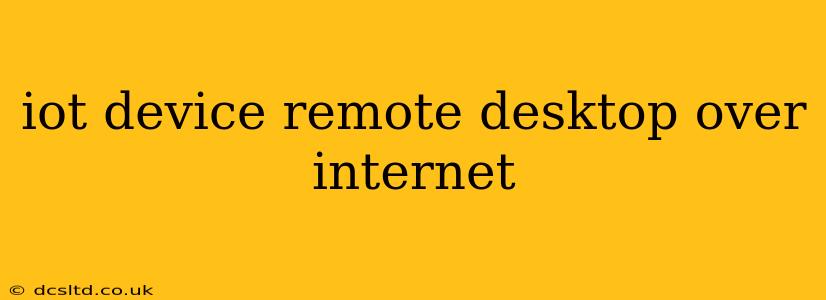The Internet of Things (IoT) has revolutionized how we interact with the world around us, connecting everyday devices to the internet. But what happens when you need to access and control these devices remotely? This guide explores the various methods for accessing an IoT device's remote desktop over the internet, discussing the security implications and best practices.
What is Remote Desktop Access for IoT Devices?
Remote desktop access for IoT devices allows you to control and manage your devices from anywhere with an internet connection. This can be incredibly useful for various applications, including monitoring home security systems, managing smart home appliances, troubleshooting industrial equipment, and more. It essentially provides a virtual window into your device's operating system, letting you interact with it as if you were sitting directly in front of it.
How to Access an IoT Device's Remote Desktop Over the Internet
Several methods enable remote desktop access to IoT devices, each with its advantages and disadvantages:
1. Using a VNC Server:
Virtual Network Computing (VNC) is a popular and widely supported protocol for remote desktop access. Many IoT devices support VNC servers. To access your device, you'll need to:
- Install a VNC server on your IoT device: This will depend on the device's operating system and capabilities.
- Configure the VNC server: This includes setting up a password and possibly configuring firewall rules to allow access from external networks.
- Use a VNC client on your computer or mobile device: Connect to your device using its IP address and the password you set.
Pros: Relatively simple to set up and widely supported. Cons: Can be less secure than other options if not properly configured. Performance can be impacted by network latency.
2. Utilizing SSH Tunneling:
Secure Shell (SSH) is a secure network protocol primarily used for remote login to servers. However, SSH tunneling can be used to create a secure connection to a VNC server on your IoT device. This adds an extra layer of security.
- Establish an SSH connection to your IoT device: This requires an SSH server installed on your device and knowing its IP address and login credentials.
- Create an SSH tunnel: This will forward a specific port on your local machine to the VNC server port on your IoT device.
- Connect to the VNC server through the tunnel: Using your VNC client, connect to the local port you forwarded.
Pros: More secure than directly accessing the VNC server. Cons: Requires a more technical understanding of networking concepts.
3. Employing Cloud-Based Remote Access Solutions:
Many cloud-based platforms offer remote access functionalities specifically designed for IoT devices. These services handle the complexities of network configuration and security, making remote access easier to set up. Popular examples include AWS IoT Core, Azure IoT Hub, and Google Cloud IoT Core. These generally require specific device and software support to be already integrated into the chosen platform.
Pros: Simplified setup and enhanced security features. Often include additional management and monitoring tools. Cons: May incur subscription fees. Requires compatibility with the chosen cloud platform.
Security Considerations When Accessing IoT Devices Remotely
Security is paramount when accessing IoT devices remotely. Failing to implement robust security measures can expose your devices and network to cyberattacks.
Strong Passwords and Authentication:
Use strong, unique passwords for all your devices and accounts. Consider multi-factor authentication whenever available to add an extra layer of security.
Firewall Configuration:
Configure firewalls on your devices and network to restrict access to only authorized users and ports.
Regular Software Updates:
Keep your IoT devices and software updated with the latest security patches to mitigate vulnerabilities.
VPN Usage:
Consider using a Virtual Private Network (VPN) to encrypt your internet traffic and further protect your devices from unauthorized access.
Frequently Asked Questions
What are the risks of remote access to IoT devices?
Remote access to IoT devices exposes them to potential security risks, such as unauthorized access, data breaches, and malware infections. Improperly configured devices can become entry points for attackers to penetrate your entire network.
How can I secure my IoT devices for remote access?
Secure your IoT devices by using strong passwords, configuring firewalls, regularly updating software, and employing VPNs. Choose reputable cloud services that offer robust security measures.
Which method is the most secure for remote access to IoT devices?
SSH tunneling combined with a cloud-based solution provides a very secure approach, combining the security benefits of both methods.
Do all IoT devices support remote desktop access?
No, not all IoT devices support remote desktop access. The availability of this functionality depends on the device's operating system, hardware capabilities, and whether the manufacturer has enabled it.
What is the best way to monitor remote IoT devices?
Cloud-based solutions often provide comprehensive monitoring and management tools to track the performance and status of your IoT devices remotely. They usually offer dashboards and alerts to notify of any issues.
This guide provides a comprehensive overview of accessing an IoT device's remote desktop over the internet. Remember, security is crucial. Always prioritize security best practices to protect your devices and network from potential threats.
